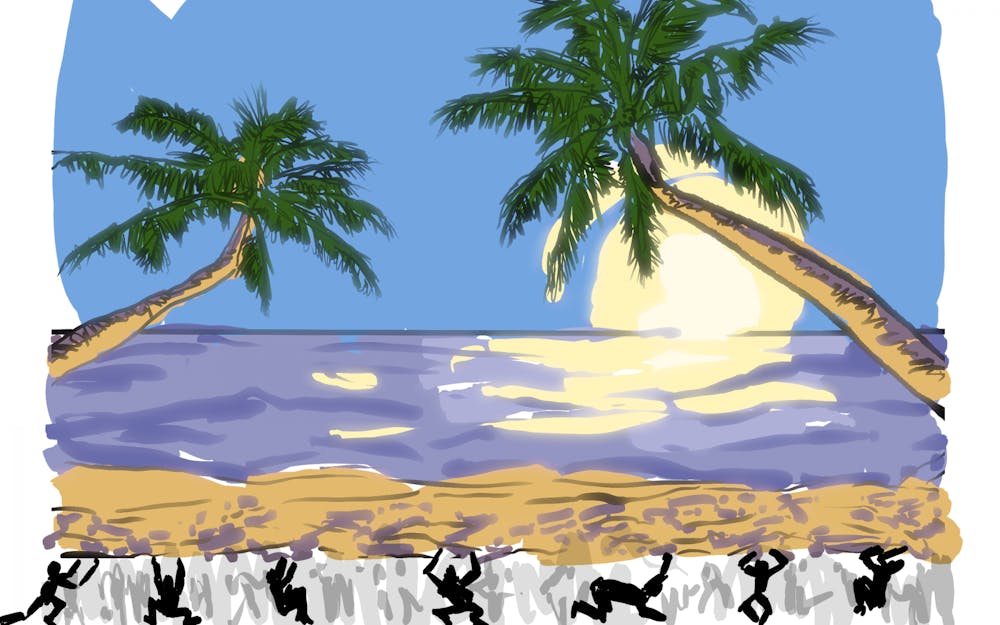“Where’d you go for spring break?”
“How was your vacation?”
“What places did you visit?”
After spring break, this chorus is probably all you’ll hear. I’ll be the first to admit it: traveling rocks. Over spring break, many of us probably did it, whether it was just driving home to visit family or hopping on a plane to Europe. As someone who grew up in Indiana, this place is, no hate, kind of boring. Seeing the sights that the rest of the world has to offer is a necessity.
But there’s a dark side to tourism – one that a lot of people don’t see through the shiny veneer of tropical destinations and all-night parties. Tourism has heavy consequences for the environment and the people who live in the most heavily traveled areas of the world.
First, let’s look at the environmental impact of tourism. Just getting to your chosen vacation destination harms the planet. The aviation industry emits about 1 billion tons of CO2 each year. I won’t be unfair and blame you for that, though. There’s not much you can do about stopping those planes unless you hop out on the tarmac with a hi-vis vest and some flashlights.
[Related: OPINION: What are we prepared to do to halt climate change]
Your vacation destination is impacted heavily as well. Important ecosystems and natural resources can be damaged or lost due to tourism. Infrastructure meant for tourists often overuses important natural resources. In 2017, the average tourist in Spain consumed 450-800 liters of water, accounting for hotels, activities and personal consumption. The average citizen consumed only 127 liters.
The environment of your vacation destination can be irreparably harmed by the presence of tourists. It’s not just the ecosystem, though. The people who live there year-round face huge consequences when tourists come to their communities.
An example of this impact is the state of Hawai’i. The tourism industry and overcrowding has forced many Native Hawaiians out of their homes. To reclaim their land, Native people have to wait 30 years or more on a government homestead waitlist. It’s often unsustainable for Native people to own a home in their own community. A median single-family home in O’ahu can run you nearly $1 million.
Across the ocean, in the Dominican Republic, an average two- or three-bedroom house in Santo Domingo, the country’s capital, costs around $150,000 in U.S. dollars. However, minimum wage is low, with the minimum monthly wage for those working at large companies being $363.95. These disparities can and will harm the people who live there year-round, but not the people who come for a week to party and then leave.
Tourists use their preferred destination spots to extract relaxation and good times, often at the expense of the real people who live there. This is a concept often referred to as neocolonialism.
Neocolonialism is the indirect control that industrialized countries have over less-developed countries. The impacts of this model hit hardest in the Global South, in areas such as Latin America, Africa and southern Asia. This form of colonialism doesn’t look like Spanish conquerors planting flags on foreign shores or British capitalists forming massive plantations. But it does look like influential tactics to keep other countries under control.
[Related: COLUMN: Growing pains - an eternal Paris, a romantic Paris]
The forces of tourism cause destinations to rely on the capital of their white and Western travelers. The money brought by these visitors often just goes to the foreign investment moguls that buy up land in these countries. In the Caribbean, around 80% of the money spent by tourists ends up in the pockets of people that live outside the country.
In the end, remember to travel mindfully. Be aware of what impacts you can make in the community and environment you’re visiting, both good and bad. Support local people, not the huge conglomerates that eat up their land and resources. You can stay at a local hotel and shop at stores owned by people who live there year-round. I promise it’s not as hard as you think. If you’re visiting important cultural sites or natural wonders, be respectful of their importance.
In short: don’t be an idiot, and everyone can have a good time.
Danny William (they/them) is a freshman studying media. They admit their bias in this article with the confession that they saw, despite the dozens of signs warning against it, several people feeding rock squirrels at Zion National Park, and it has haunted them ever since.




